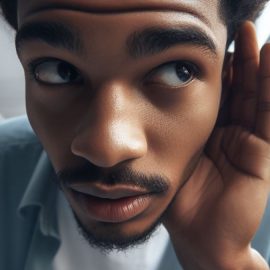

This article is an excerpt from the Shortform book guide to "The Like Switch" by Jack Schafer and Marvin Karlins. Shortform has the world's best summaries and analyses of books you should be reading.
Like this article? Sign up for a free trial here.
What is nonverbal communication? What is the key to understanding nonverbal communication?
Nonverbal communication is the facial expressions and gestures you make that communicate how you feel. To consciously assess where strangers might fall on the friendship spectrum, you need to know how to translate nonverbal cues.
If you want to understand nonverbal communication like a pro, read below.
Spotting Friendly Cues
There are many ways to understand nonverbal communication. According to Jack Schafer and Marvin Karlins in their book The Like Switch, the following behaviors communicate friendliness, confidence, and trust. If you see people displaying these cues, they’re willing to be your friend. You can also exhibit these behaviors yourself to invite new connections.
Smiling
This is one of the most powerful ways to signal affection and openness. Furthermore, smiling people are seen as more attractive and more confident.
Eyebrow Movement
Another cue that signals friendliness when greeting others is lifting your eyebrows and returning them to their resting position in a single, rapid movement. If someone doesn’t flash their eyebrows in greeting, we subconsciously perceive that person as someone to avoid.
Tilting Your Head to the Side
This cue shows that you aren’t a threat. When you tilt your head and expose your neck, you leave your carotid artery vulnerable, displaying trust toward the other person.
Eye Contact
You can use eye contact to nonverbally get people’s attention. If you don’t know someone very well but want to show interest, lock eyes with them for about a second, look away, then look back. You can also use eye contact to show that you’re actively listening.
Leaning Forward
This communicates interest in the other person. Generally, people with good rapport orient their torsos toward each other during a conversation.
Matching Body Language
When you have a strong connection with someone, you naturally match their body language during your interactions. For example, if you lean against a wall or take a sip of your drink, a friend will repeat those actions unconsciously. If a person’s body language contrasts with yours, there’s some dissonance in the interaction.
Touching
Different kinds of casual touches, like a hug or a light touch on the arm, can be a great way to communicate affection and support in friendships. However, everyone’s personal boundaries are different, so be aware of negative reactions to touching that suggest discomfort or disapproval, like pulling away or stepping back.
Spotting Unfriendly Cues
Now that you’ve learned the cues you can use to spot friends, we’ll discuss the various ways people nonverbally communicate that they want others to stay away. The authors advise that we often display these cues without knowing it, even when we want to make friends. Understanding these nonverbal communication cues can therefore help you recognize if you’re unconsciously pushing people away, as well as helping you spot when others aren’t interested in being friends with you.
Staring Excessively and Looking Someone Up and Down
Both of these actions are perceived as aggressive and invasive, signaling to the other person that you pose a threat.
Rolling Your Eyes
This signals contempt and disapproval toward a person’s words or actions. If you’re talking to someone and they roll their eyes, they disagree with what you have to say.
Tension in Your Face
If you display a tight jaw, a furrowed brow, and narrowed eyes, you’re communicating threatening messages. Often, we’re just tense about the stressors of our daily lives, but potential friends can easily misinterpret that as unfriendliness.
Crossing Your Arms
This is a protective gesture that places a barrier between you and the other person. It signals anxiety and discomfort.
Invading Personal Space
We all desire a certain amount of empty space around us, and we want other people to respect this space. If people invade our boundaries, we perceive them as a threat. For example, imagine you’re standing on a nearly empty train platform, and another passenger approaches. Instead of standing a respectful distance away, they choose to stand right next to you, even though there’s plenty of space to spread out. This will most likely make you feel irritated and uncomfortable because your personal space has been violated.

———End of Preview———
Like what you just read? Read the rest of the world's best book summary and analysis of Jack Schafer and Marvin Karlins's "The Like Switch" at Shortform.
Here's what you'll find in our full The Like Switch summary:
- How to cultivate the qualities you need to attract and connect with new friends
- How to have meaningful, smooth conversations with friends
- How you can productively manage conflict in relationships






